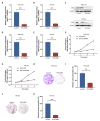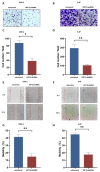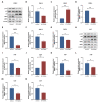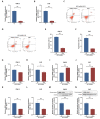Kinesin superfamily member 15 knockdown inhibits cell proliferation, migration, and invasion in nasopharyngeal carcinoma
- PMID: 37641808
- PMCID: PMC10466069
- DOI: 10.4196/kjpp.2023.27.5.457
Kinesin superfamily member 15 knockdown inhibits cell proliferation, migration, and invasion in nasopharyngeal carcinoma
Abstract
The aim of this study was to investigate the role of kinesin superfamily member 15 (KIF15) in nasopharyngeal carcinogenesis (NPC) and explore its underlying mechanisms. We employed various assays, including the CCK-8 assay, flow cytometry, the Transwell and scratch assay, Western blotting, and nude mice transplantation tumor, to investigate the impact of KIF15 on NPC. Our findings demonstrate that KIF15 plays a critical role in the proliferation, apoptosis, migration, and invasion of NPC cells. Furthermore, we discovered that silencing KIF15 inhibits cell proliferation, migration, and invasion while promoting apoptosis, and that KIF15's effect on NPC cell growth is mediated through the PI3K/AKT and P53 signaling pathways. Additionally, we showed that KIF15 promotes nasopharyngeal cancer cell growth in vivo. Our study sheds light on the significance of KIF15 in NPC by revealing that KIF15 knockdown inhibits NPC cell growth through the regulation of AKT-related signaling pathways. These findings suggest that KIF15 represents a promising therapeutic target for the prevention and treatment of NPC.
Keywords: Cell proliferation; Kinesins; Nasopharyngeal carcinoma.
Conflict of interest statement
The authors declare no conflicts of interest.
Figures








Similar articles
-
Downregulation of KIF15 inhibits the tumorigenesis of non-small-cell lung cancer via inactivating Raf/MEK/ERK signaling.Histol Histopathol. 2022 Mar;37(3):269-285. doi: 10.14670/HH-18-408. Epub 2021 Dec 15. Histol Histopathol. 2022. PMID: 34908156
-
Knockdown of Kinesin Family 15 Inhibits Osteosarcoma through Suppressing Cell Proliferation and Promoting Cell Apoptosis.Chemotherapy. 2019;64(4):187-196. doi: 10.1159/000505014. Epub 2020 Feb 19. Chemotherapy. 2019. PMID: 32074608
-
Saucerneol attenuates nasopharyngeal carcinoma cells proliferation and metastasis through selectively targeting Grp94.Phytomedicine. 2022 Jul;101:154133. doi: 10.1016/j.phymed.2022.154133. Epub 2022 Apr 26. Phytomedicine. 2022. PMID: 35504052
-
Downregulation of Bmi-1 is associated with suppressed tumorigenesis and induced apoptosis in CD44⁺ nasopharyngeal carcinoma cancer stem-like cells.Oncol Rep. 2016 Feb;35(2):923-31. doi: 10.3892/or.2015.4414. Epub 2015 Nov 12. Oncol Rep. 2016. PMID: 26573774
-
KIF15 promotes the development and progression of chordoma via activating PI3K-AKT signalling pathway.Heliyon. 2024 Apr 9;10(8):e29386. doi: 10.1016/j.heliyon.2024.e29386. eCollection 2024 Apr 30. Heliyon. 2024. PMID: 38681556 Free PMC article.
Cited by
-
METTL3 methylated KIF15 promotes nasopharyngeal carcinoma progression and radiation resistance by blocking ATG7-mediated autophagy through the activation of STAT3 pathway.Transl Oncol. 2025 Jan;51:102161. doi: 10.1016/j.tranon.2024.102161. Epub 2024 Nov 5. Transl Oncol. 2025. PMID: 39504712 Free PMC article.
-
KIF15 promotes human glioblastoma progression under the synergistic transactivation of REST and P300.Int J Biol Sci. 2024 Sep 23;20(13):5127-5144. doi: 10.7150/ijbs.98668. eCollection 2024. Int J Biol Sci. 2024. PMID: 39430242 Free PMC article.
-
Carboxylesterase 4A Inhibits the Malignant Biological Behavior of Nasopharyngeal Carcinoma via the PI3K/AKT Pathway.Technol Cancer Res Treat. 2025 Jan-Dec;24:15330338251319144. doi: 10.1177/15330338251319144. Technol Cancer Res Treat. 2025. PMID: 39912257 Free PMC article.
-
The multifaceted role of KIF15 in cancer progression and therapy.Invest New Drugs. 2025 Aug 16. doi: 10.1007/s10637-025-01572-1. Online ahead of print. Invest New Drugs. 2025. PMID: 40817978 Review.
References
-
- Tang SQ, Mao YP, Xu C, Guo R, Li WF, Tang LL, Sun Y, Ma J. The evolution of the nasopharyngeal carcinoma staging system over a 10-year period: implications for future revisions. Chin Med J (Engl) 2020;133:2044–2053. doi: 10.1097/CM9.0000000000000978.45b20d7da1104cda981fe16dd2ef952e - DOI - PMC - PubMed
-
- Hung CC, Tu MY, Chien TW, Lin CY, Chow JC, Chou W. The model of descriptive, diagnostic, predictive, and prescriptive analytics on 100 top-cited articles of nasopharyngeal carcinoma from 2013 to 2022: bibliometric analysis. Medicine (Baltimore) 2023;102:e32824. doi: 10.1097/MD.0000000000032824. - DOI - PMC - PubMed
LinkOut - more resources
Full Text Sources
Research Materials
Miscellaneous

